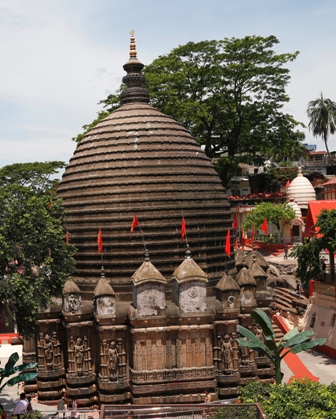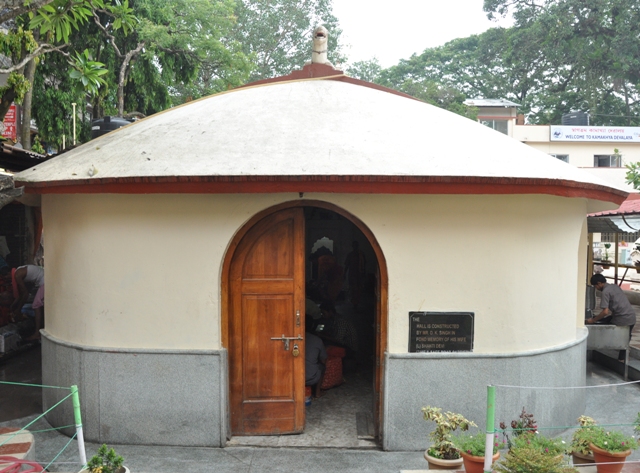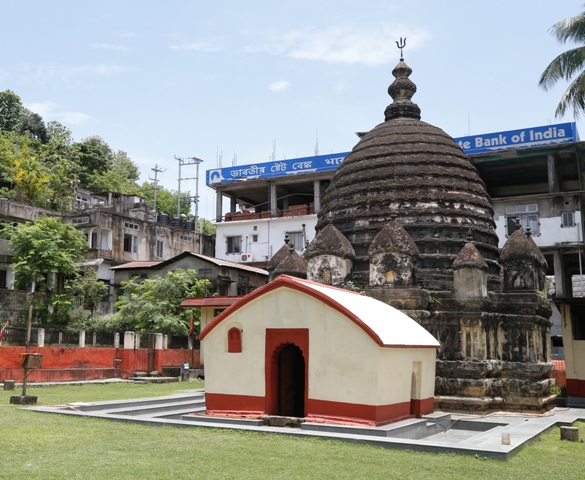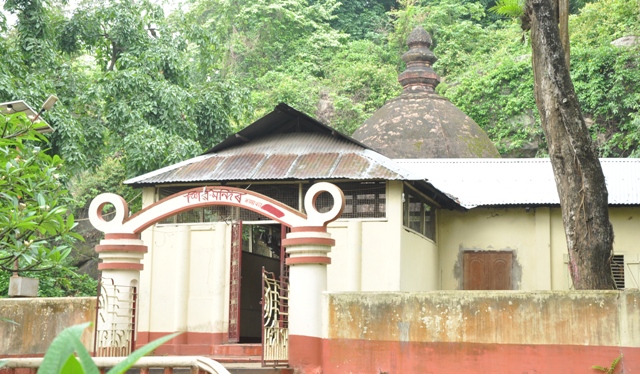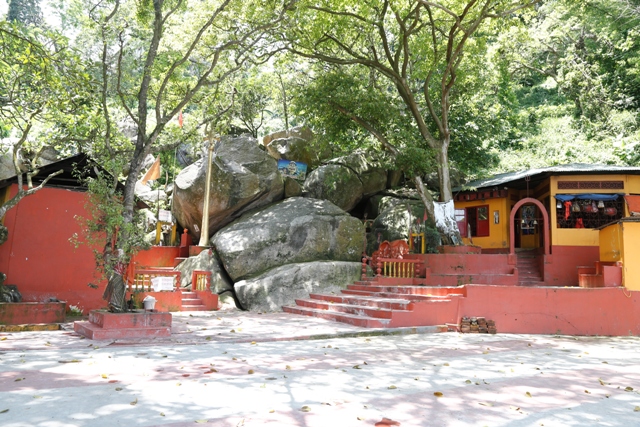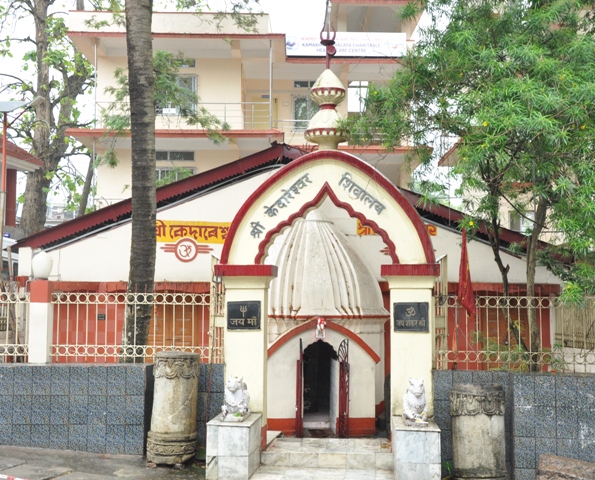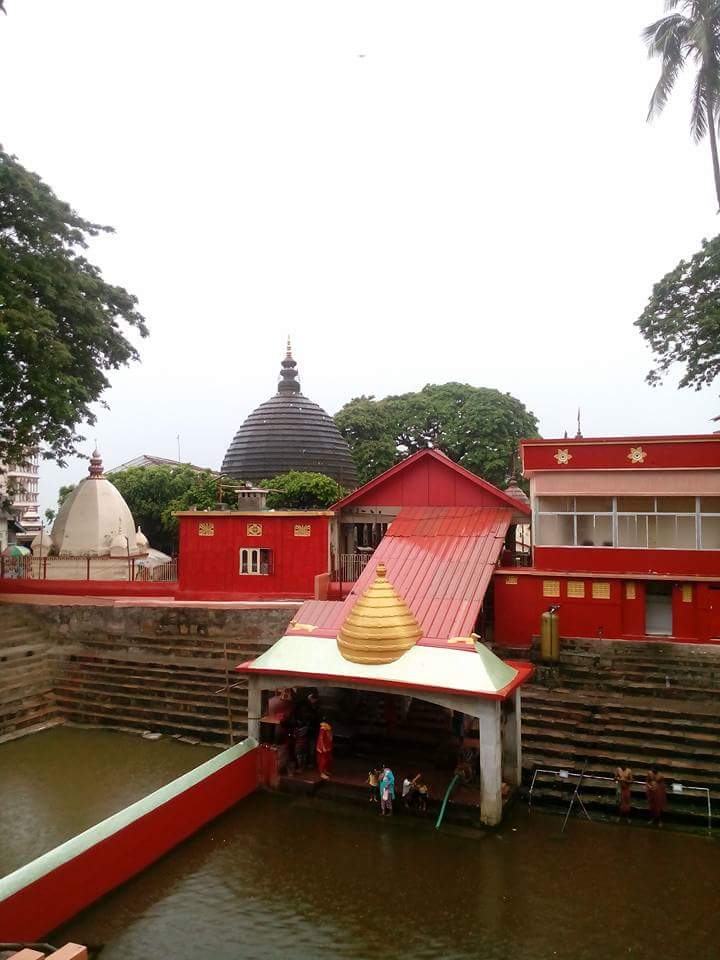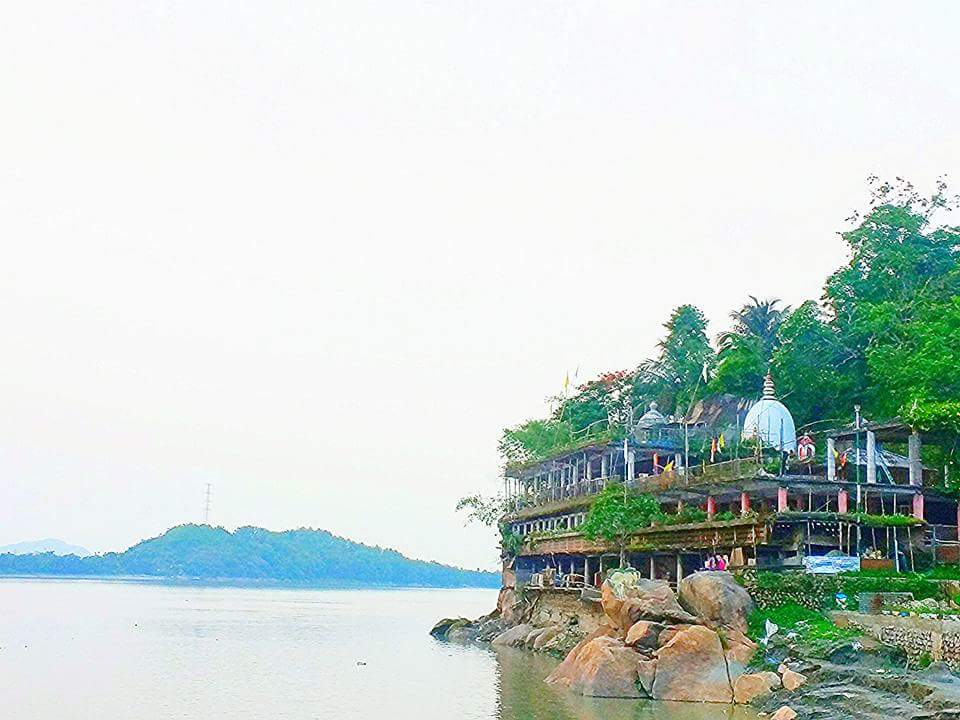Maa Kamakhya or Kameswari is the renowned Goddess of Desire whose famous shrine is located in the heart of Nilachala Hill situated in the western part of Guwahati, the Capital City of the state of Asom in North East India. Maa Kamakhya Devalaya is considered most sacred and oldest of the 51 Shakti Peethas on earth. It is the centrepiece of widely practiced, powerful Tantrik Shaktism cult in India.
Apart from the main temple of Maa Kamakhya ,there are temples of the Dasamahavidya (ten incarnations of the deity) namely Kamakhya (i.e. Tripura Sundari, alongwith Matangi and Kamala), Kali, Tara, Bhuvaneshvari, Bagalamukhi, Chinnamasta, Bhairavi, Dhumavati, and five temples of Lord Shiva namely Kameswara, Siddheswara, Kedareswara, Amratokeswara, Aghora and Kautilinga around the Nilachala Hill which is also called as Kamakhya Temple Complex.
Maa Kamakhya or Kameswari is the renowned Goddess of Desire whose famous shrine is located in the heart of Nilachala Hill situated in the western part of Guwahati, the Capital City of the state of Asom in North East India. Maa Kamakhya Devalaya is considered most sacred and oldest of the 51 Shakti Peethas on earth. It is the centrepiece of widely practiced, powerful Tantrik Shaktism cult in India.
Apart from the main temple of Maa Kamakhya ,there are temples of the Dasamahavidya (ten incarnations of the deity) namely Kamakhya (i.e. Tripura Sundari, alongwith Matangi and Kamala), Kali, Tara, Bhuvaneshvari, Bagalamukhi, Chinnamasta, Bhairavi, Dhumavati, and five temples of Lord Shiva namely Kameswara, Siddheswara, Kedareswara, Amratokeswara, Aghora and Kautilinga around the Nilachala Hill which is also called as Kamakhya Temple Complex.
Kamakhya Devalaya is inter-mixed with oral history and legends, sometimes these soutrces reflect different periods of time. Mention of Kamakhya has been made in various ancient literatures e.g. Devi Bhagawat, Devi Purana, Kalika Purana, Yogini Tantra, Hevajra Tantra etc. The origin of the Kamakhya Temple is believed to be pre-Aryan or tribal in traits and rituals by many. But religious literature tells us that the original temple was built by Kamdev who regained his beauty here. Built with the help of Bishwakarma, this temple was believed to be a gigantic structure and probably was much bigger than the present one. It was full of beautiful architechtural and sculptural wonder. However, due to some unknown reasons, the upper portion of the temple was completely destroyed. For a long time, the temple lost its importance due to the rise of Shaivism among the rulers and the subject of what was known as Pragjyotisha Kingdom. The Kamakhya Temple’s origin are said to be pre-Aryan.
From the historical point of view, the temple can be presumed to have come into prominence during the reign of King Naraka who is said to be the earliest paramount ruler of the Brahmaputra Valley. But among the successors of Naraka, nothing written or evidential reference of patronage towards the temple is to be found and its history became obsecure till the rise of the Koch Kingdom during the mid 16th Century AD.
How to Reach
Lokpriya Gopinath Bordoloi International Airport, also known as Guwahati International Airport, is the major airport in all of North East India. The airport is well connected with all the major cities of Indian and a few select international cities like Bangkok and Paro. The airport is about 20 kilometres west of the city centre. From the airport, you can book a taxi/cab or board a bus to get to the city centre or to your hotel
Kamakhya Station is the second largest station of the city and is nearest to Kamakhya Devalaya. Guwahati Station is the major railway station of Guwahati. Guwahati is well connected with all the major cities of the country through rails. From the railways station, you can hire a cab/taxi or board a local bus to get to the city centre or to your hotel.
Guwahati is very well connected with the adjoining cities and states through bus service. The three nodal points of Adabari, Paltan Bazar and ISBT Guwahati, provide bus services to towns and cities in Assam and adjoining states.
Places to visit around Nilachal Hill
Kamakhya is known not only for the main attraction i.e Maa Kamakhya Temple, but also for some other temples like Devi's Dashamahavidya temples, temples of Lord Shiva and some other temples.
MahaKali
×
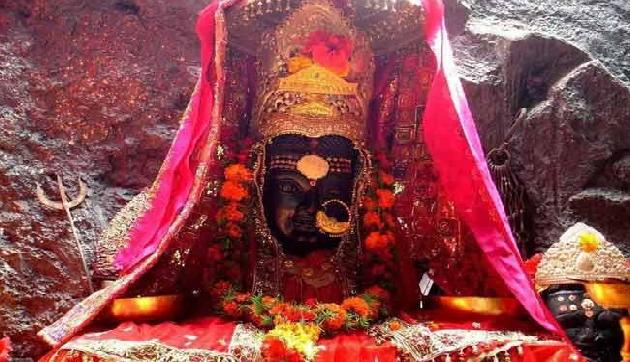
Mahakali is considered to be the prime Goddess for sadhana. This form of the Devi is dark-skinned with disheveled hair with a garland of severed human heads. She holds a severed human head and a kharga (a large machete) in her left hands and a barmudra and in her right hand.
She is having a half-moon on her forehead. Mahakali's major forms are Dakshinakali, Gujyakali, Bhadrakali, Sashankali and Mahakalbhairavi. Dakshinakali is adhisthatri devi who governs the planet Shani. So she is worshipped on Saturday. The temple to Mahakali is situated in east of Kamakhya.
Close
Tara
×
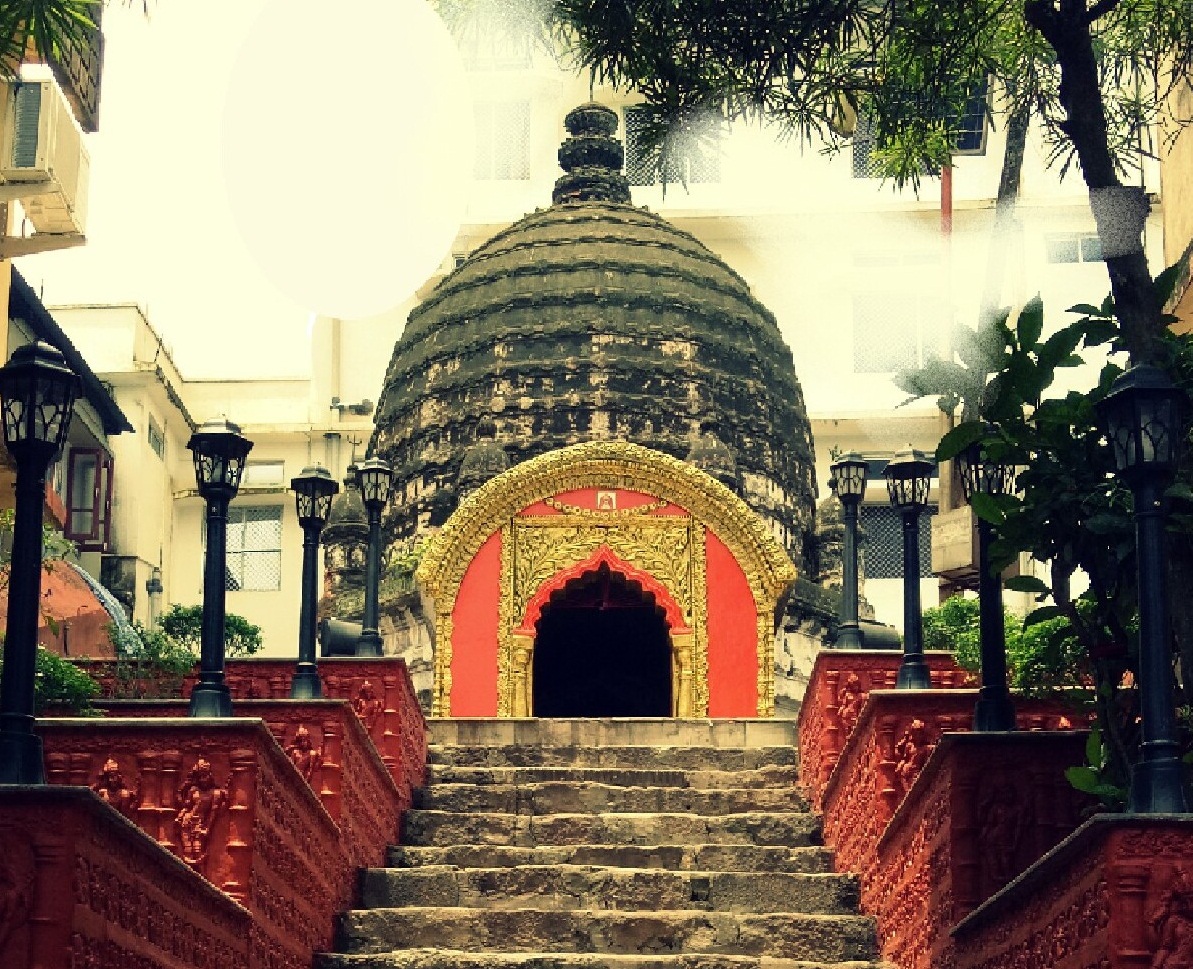
Tara Devi gives ‘Bak-shakti’ i.e power of speech. She is also 'Nil Saraswati'. Devi is fair-skinned, three eyes and four hands. She holds a Kharga, a Kartarika, a severed human head and a water lily. She wears a garland of human heads and wears a Tiger Skin. Tara Devi is shown standing on a pyre. According to Maya Tantra, Tara Devi has eight forms: Tara, Urga, Mohagra, Bajra, Nila, Saraswati, Kameshwari and Bhadrakali. When prayed she comes to the aid of people in trouble and so known as 'Tara'.
As Nil Saraswati, She grants power of speech. As Ugratara, She protects people from deep fear. Sage Basistha placed Tara Devi near Jorpukhuri of present Guwahati-the famous mandir is known a ‘Ugratara Mandir’. The Tara mandir in Nilachal Parvat lies between Mahakali and Kamakhya temple. Tara is the adhisthatri devi of Guru Brihaspati (Thursday) and is considered Devi who guides and protects and offers the ultimate knowledge that leads to salvation.
Close
Bhairavi
×
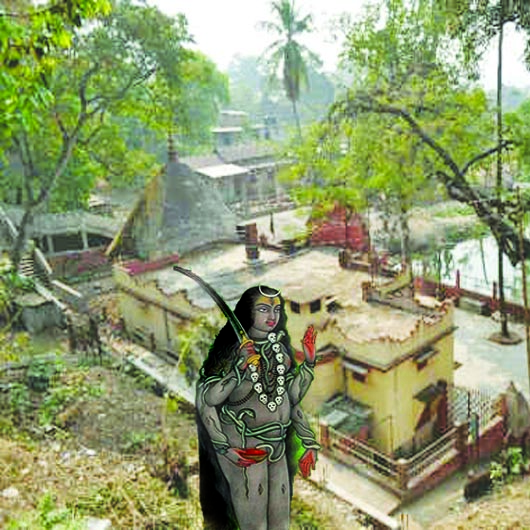
The colour of Devi's skin is like that of the mid-morning sun. She is clad in a red vastra (garment). In her four hands she takes a Borda (large machete), a Pushtak (book) and Japmala (prayer beads) and fourth hand is in Abhaymudra gesture. She also has a garland of human heads, her eyes are as bright as a red lotus. Devi Bhairavi has 13 different forms:
- Tripura Bhairavi
- Sampadprada Bhairavi
- Kaulesh Bhairavi
- Chaitanya Bhairavi
- Kameshwari Bhairavi
- Kameshwari Bhairavi
- Satkuta Bhairavi
- Nitya Bhairavi
- Rudra Bhairavi
- Bhubaneshwari Bhairavi
- Tripurabala Bhairavi
- Bhaibiddhangshini Bhairavi
(m) Annapurna Bhairavi who has five faces
Close
Chinnamasta
×
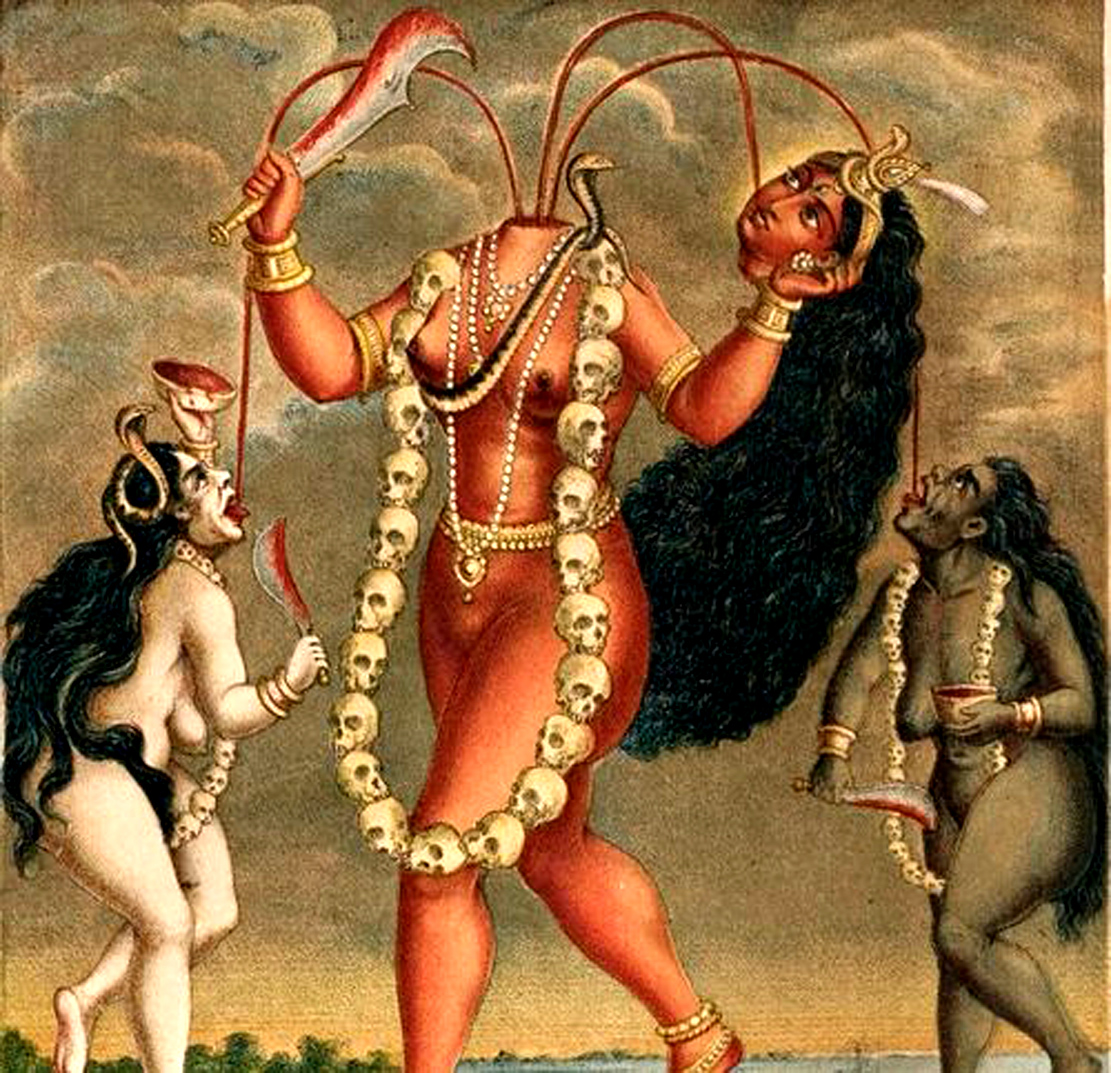
Chhinnamasta Devi is headless and is in a fearsome look. Her cutout head lies next to her. She is shown drinking the blood that sprouts out of Her neck. Her hair is not tied disciplined. She holds human heads and weapons in her hands. She too wears a garland of human heads and her left leg in a forward position. Moreover, devi is seem standing on Madan (Kam) and Rati who are locked in an embrace. Devi's main associates Bornini and Dakini are nearby and also and the blood that comes out like a fountain from Devi's neck. Chinnamasta Devi is the adhisthatri devi of Rahu (Wednesday). This temple of nilachal parvat adjoins the Kameshwar temple is only accessed through a steep and narrow flight of stairs that tests one's physical skills to reach.
Close
Dhumawati
×
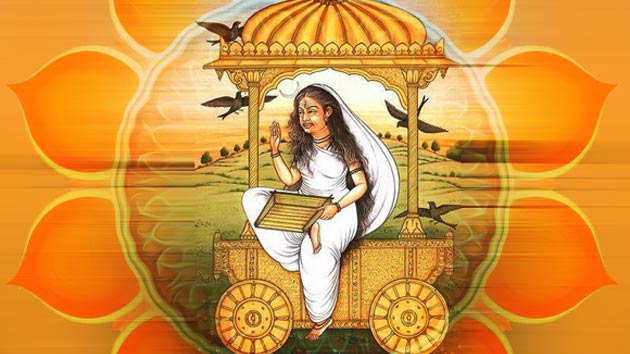
Colour of Devi is pale-skinned, tall, restless and wears dirty clothes. She is in the form of a widow. She has rukhya eyes and holds weapons in her three hands while the fourth is in a bormudra gesture. She has a large ugly nose and a fearsome look. Dhumawati devi is the adhisthatri devi of Ketu (Thursday). The colour of this widow devi is naturally white.
Close
Bagalamukhi
×
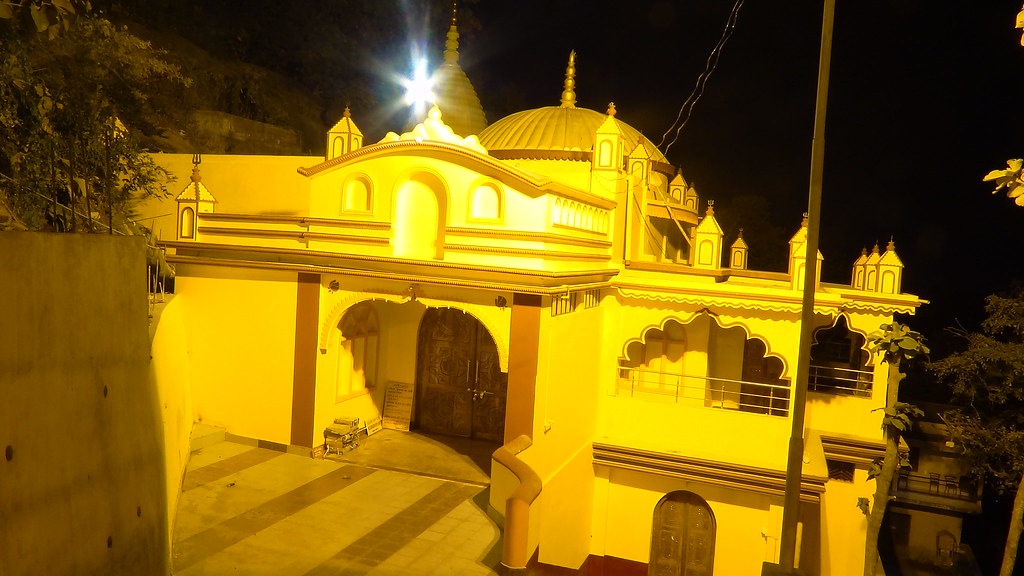
Mahakali is considered to be the prime Goddess for sadhana. This form of the Devi is dark-skinned with disheveled hair with a garland of severed human heads. She holds a severed human head and a kharga (a large machete) in her left hands and a barmudra and in her right hand.
She is having a half-moon on her forehead. Mahakali's major forms are Dakshinakali, Gujyakali, Bhadrakali, Sashankali and Mahakalbhairavi. Dakshinakali is adhisthatri devi who governs the planet Shani. So she is worshipped on Saturday. The temple to Mahakali is situated in east of Kamakhya.
Close
Maa Bhubaneshwari
×
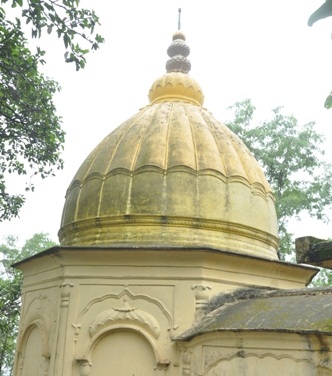
The colour of Bhubaneswari Devi's skin is like the rays of the sun at dawn.There is a half-moon on her forehead, has three eyes. Out of four hands,in two hands She holds a spear and a lasso while the other two hands are in the- Barmudra and Abhaymudra. Bhubaneshwari temple is situated at elevation 690feet, highest point of Nilachal Parvat. The Puranas say that Bhubaneshwari temple is at the top of the Brahma Parvat, so Nilachal Parvat is no other than Brahma Parvat. Devi is mother of universe whose Body is the Cosmos. Childless couples with marital problems will get boon from Devi who is adhisthatri devi of Shukra (Friday).
Close
Matangi & Kamala
×
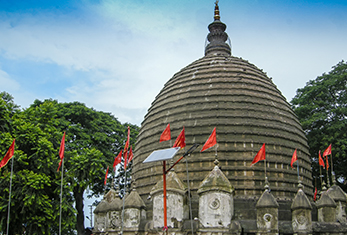
Matangi Devi is the `Tantric Saraswati' and the adhisthatri devi of Rabi (Sunday). She sits on a bejeweled throne, sports a white half-moon on her forehead. In her four hands She holds a kharga, khetak, lasso and spear. Apart from the natural naibaidya, She likes rice custard sweetened with sugar. Kamala Devi is the `Tantric Lakshmi' and the adhisthatri devi of the Moon (Monday). She wears a crown of jewels, is wraped in a red vastra. Godness is seated on a lotuses in two hands and other two are in the bormudra and abhaymudra gesture. Four white elephants around her are seen performing abhishek. The two devis Matangi and Kamala are seated in the garba griha of the main temple to the east of the Yoni Mudra Peeth.
SApart from these ten `Dasamahavidya' temples in Nilachal Parbat, there are five temples dedicated to Maheshwar (Shiva). They are Siddheshwar, Kameshwar, Kotilinga, Amra Tokreshwar and Kedareshwar. Of these Shiva temples, the Kotiling and Siddheshwar can be reached after short treks downhill while Kameshwar is within the main Kamakhya temple complex. Tokreshwar temple is connected with a motorable road and is situated just beside the Brahmaputra river. Kedareshwar is adjacent to the Kamakhya temple complex. The other temples in Nilachal Parbat are the Jai Durga, Bana Durga, Namath Kali, Hanuman, Ganesh, Pandunath, Gadadhar and Sitala temples. The kundas or ponds in Nilachal Parvat are: Saubhagya kunda, Wrin Mochan kunda, Amrit kunda, Durga kunda, Gaya kunda and Kaso Pukhuri. It is said that a round of all the temples in Nilachal Parbat on foot an arduow task that would take a couple of days is sure to help achive complete salvation.
Close
Matangi & Kamala
×
She is the main form of Maa Kamakhya and ensures the well-being of all living creatures. Devi is as bright as the new sun. She holds a bow, arrow, rope and lasso in her four hands. She is seated in Mahakal's lap and is in a happy and satiated state of mind.
For more information visit https://www.maakamakhya.org
✍ Share Your Knowledge with Our Community!
get rewards for paying bills
upto ₹250 off when you pay your first bill on CRED

